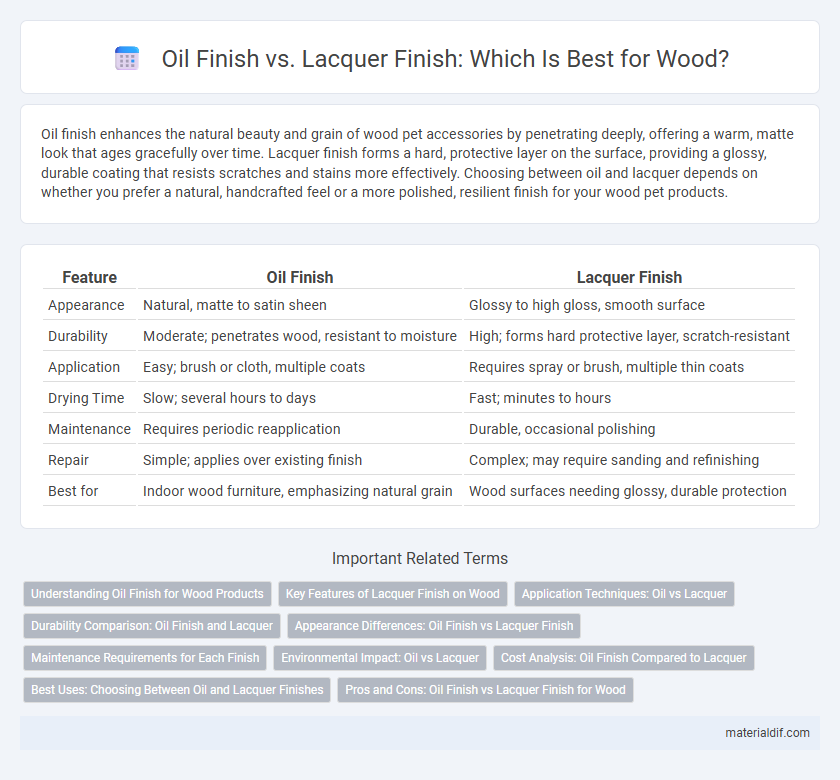Oil finish enhances the natural beauty and grain of wood pet accessories by penetrating deeply, offering a warm, matte look that ages gracefully over time. Lacquer finish forms a hard, protective layer on the surface, providing a glossy, durable coating that resists scratches and stains more effectively. Choosing between oil and lacquer depends on whether you prefer a natural, handcrafted feel or a more polished, resilient finish for your wood pet products.
Table of Comparison
| Feature | Oil Finish | Lacquer Finish |
|---|---|---|
| Appearance | Natural, matte to satin sheen | Glossy to high gloss, smooth surface |
| Durability | Moderate; penetrates wood, resistant to moisture | High; forms hard protective layer, scratch-resistant |
| Application | Easy; brush or cloth, multiple coats | Requires spray or brush, multiple thin coats |
| Drying Time | Slow; several hours to days | Fast; minutes to hours |
| Maintenance | Requires periodic reapplication | Durable, occasional polishing |
| Repair | Simple; applies over existing finish | Complex; may require sanding and refinishing |
| Best for | Indoor wood furniture, emphasizing natural grain | Wood surfaces needing glossy, durable protection |
Understanding Oil Finish for Wood Products
Oil finish penetrates deep into the wood grain, enhancing natural texture and providing a durable, water-resistant barrier. It retains the wood's breathability, allowing moisture to escape and reducing the risk of cracking or peeling common in surface coatings. Compared to lacquer, oil finishes require regular maintenance but offer superior enrichment of wood's color and grain patterns, making them ideal for furniture and decorative wood products.
Key Features of Lacquer Finish on Wood
Lacquer finish on wood offers a durable, high-gloss surface that enhances the natural grain and provides excellent resistance to scratches and moisture. It dries quickly, creating a hard, protective layer that is easy to clean and maintain. This finish is ideal for furniture and cabinetry where a sleek, polished appearance and long-lasting protection are desired.
Application Techniques: Oil vs Lacquer
Oil finish requires applying thin coats with a cloth or brush, allowing each layer to penetrate and dry thoroughly, typically taking several hours between coats. Lacquer finish demands multiple thin layers sprayed or brushed on with rapid drying times, enabling faster recoating but requiring well-ventilated areas due to strong fumes. Proper sanding between lacquer layers ensures a smooth, durable surface, whereas oil finishes rely on natural absorption and buildup for protection.
Durability Comparison: Oil Finish and Lacquer
Oil finish penetrates the wood, providing long-lasting protection against moisture and wear while enhancing the natural grain. Lacquer finish forms a hard, durable surface layer that resists scratches and impacts more effectively than oil. Compared to oil finish, lacquer offers superior durability for high-traffic areas but may require professional application and regular maintenance to preserve its protective qualities.
Appearance Differences: Oil Finish vs Lacquer Finish
Oil finish enhances wood grain with a rich, natural look that deepens over time, providing a warm, matte to satin sheen. Lacquer finish creates a smooth, glossy surface with high reflectivity, offering a more polished and durable appearance. Oil finishes emphasize texture and depth, while lacquer finishes highlight brightness and uniformity.
Maintenance Requirements for Each Finish
Oil finish penetrates wood fibers, requiring periodic reapplication every 6 to 12 months to maintain protection and enhance natural grain, especially in high-use areas. Lacquer finish forms a hard, protective surface that typically needs less frequent maintenance but may require professional refinishing or sanding if damaged, as it is more prone to chipping and scratching. Proper cleaning of lacquer involves gentle, non-abrasive methods to preserve its glossy appearance, while oil finishes benefit from regular wiping and occasional light sanding to sustain their matte or satin sheen.
Environmental Impact: Oil vs Lacquer
Oil finishes are generally more environmentally friendly due to their natural ingredients and lower volatile organic compound (VOC) emissions compared to lacquer finishes. Lacquers typically contain higher levels of VOCs and solvents that contribute to air pollution and pose health risks during application and curing. Choosing oil finishes reduces environmental impact by minimizing toxic fumes and promoting sustainable wood care.
Cost Analysis: Oil Finish Compared to Lacquer
Oil finishes generally incur lower upfront costs due to inexpensive materials like linseed or tung oil, but require frequent maintenance and reapplication which can increase long-term expenses. Lacquer finishes involve higher initial costs from specialized products and professional application, yet offer superior durability that reduces maintenance frequency and cumulative expenses over time. Cost analysis favors oil finishes for budget-conscious projects with low traffic, while lacquer provides greater value in high-traffic or commercial wood surfaces through extended lifespan.
Best Uses: Choosing Between Oil and Lacquer Finishes
Oil finishes penetrate wood, enhancing its natural grain and providing a durable, water-resistant surface ideal for furniture and cutting boards. Lacquer finishes form a hard, glossy coating that offers superior protection against scratches and chemicals, making them perfect for high-traffic areas and decorative woodwork. Selecting between oil and lacquer depends on desired appearance, durability needs, and maintenance preferences.
Pros and Cons: Oil Finish vs Lacquer Finish for Wood
Oil finish penetrates wood fibers, enhancing natural grain and providing a warm, matte look while offering moderate protection against moisture and wear; it requires periodic reapplication to maintain durability. Lacquer finish forms a hard, glossy surface that is highly resistant to scratches, chemicals, and water, making it ideal for high-traffic areas but prone to yellowing and cracking over time. Choosing oil finish emphasizes natural aesthetics and easier repair, whereas lacquer finish prioritizes lasting protection and a polished appearance.
Oil Finish vs Lacquer Finish Infographic

 materialdif.com
materialdif.com